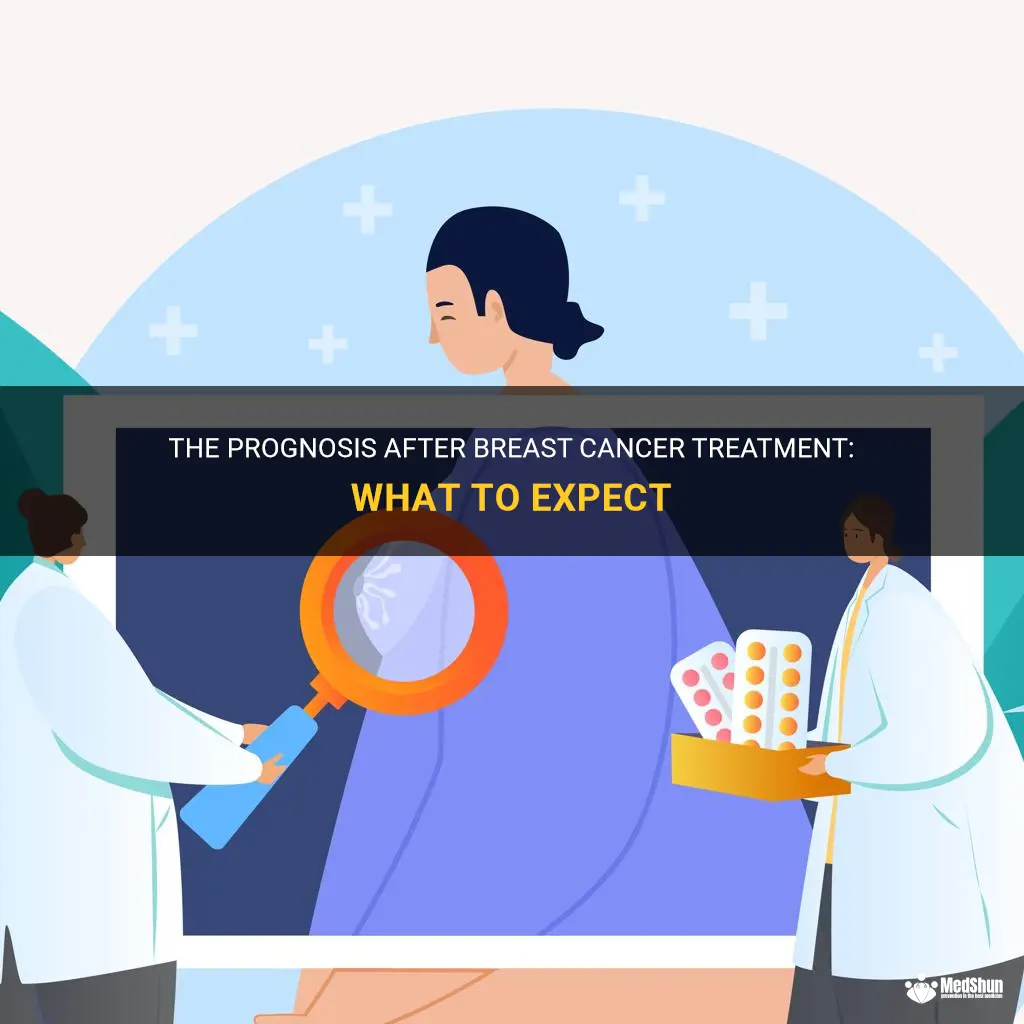
Breast cancer is a devastating disease that affects millions of women worldwide. While early detection and treatment have improved survival rates, many survivors still face the daunting task of living with the uncertainty of their prognosis. After undergoing treatment, survivors must navigate the uncharted waters of life after cancer, often grappling with questions about their long-term health, recurrence risk, and quality of life. In this article, we will explore the latest developments in breast cancer prognosis and shed light on the factors that influence a survivor's outlook. Whether you are a breast cancer survivor, a loved one, or simply interested in the topic, this article will provide valuable insights into the journey after breast cancer treatment.
| Characteristics | Values |
|---|---|
| Age | Varies, typically diagnosed after age 50 |
| Stage | Staging determines the extent of cancer |
| Hormone receptor status | Positive or negative |
| HER2 status | Positive or negative |
| Lymph node involvement | Presence or absence of lymph node spread |
| Tumor size | Measured in centimeters |
| Grade | Consists of three levels: low, medium, high |
| Estrogen receptor status | Positive or negative |
| Progesterone receptor status | Positive or negative |
| Ki-67 index | Measures cell proliferation rate |
| Oncotype DX score | Predicts recurrence risk and benefit of chemo |
| BRCA mutation status | Presence or absence of genetic mutation |
What You'll Learn
- What factors contribute to a positive prognosis after breast cancer treatment?
- How does the stage of breast cancer at diagnosis affect the prognosis after treatment?
- Are there any specific treatments or therapies that can improve the long-term prognosis for breast cancer patients?
- What follow-up screenings and tests are recommended after breast cancer treatment to monitor prognosis?
- Can lifestyle changes, such as diet and exercise, impact the prognosis for breast cancer survivors?

What factors contribute to a positive prognosis after breast cancer treatment?
Breast cancer is one of the most common types of cancer in women. The prognosis for breast cancer patients depends on various factors, including the stage of the cancer at diagnosis, the type of treatment received, and individual characteristics of the patient. In recent years, advancements in medical treatments and a better understanding of the disease have led to improved outcomes for many breast cancer patients.
One of the key factors that contribute to a positive prognosis is the stage at which the cancer is diagnosed. Breast cancer is classified into four stages, with stage 0 being non-invasive and stage IV being metastatic, or cancer that has spread to other parts of the body. Generally, the earlier the stage at diagnosis, the better the prognosis. This is because early-stage breast cancer is often easier to treat and has a higher chance of being cured.
The type of treatment received also plays a significant role in determining the prognosis. The standard treatment options for breast cancer include surgery, radiation therapy, chemotherapy, hormone therapy, and targeted therapy. The specific treatment plan is determined based on factors such as the type and stage of cancer, as well as the patient's overall health. In general, a multidisciplinary approach that combines different treatment modalities leads to better outcomes.
Surgery is often the first line of treatment for breast cancer and can involve either a lumpectomy, which removes only the tumor and surrounding tissue, or a mastectomy, which removes the entire breast. Studies have shown that breast-conserving surgery, such as a lumpectomy followed by radiation therapy, can be just as effective as mastectomy for early-stage breast cancer. However, the choice of surgery ultimately depends on the individual patient's preferences and the recommendation of the treating physician.
In addition to surgery, radiation therapy is often used to treat breast cancer. This involves targeting high-energy x-rays to the affected area to kill cancer cells. Radiotherapy is typically given after surgery, either as a precautionary measure to kill any remaining cancer cells or as a primary treatment for inoperable tumors.
Chemotherapy is another common treatment for breast cancer and involves the use of powerful drugs to kill cancer cells. Chemotherapy is often recommended for patients with larger tumors or cancer that has spread to the lymph nodes. However, not all breast cancer patients require chemotherapy, and the decision to undergo this treatment is based on the individual case.
Hormone therapy is often used to treat breast cancer that is hormone-receptor positive, meaning that the cancer cells have receptors for estrogen or progesterone. This treatment works by blocking the effects of these hormones, which can promote the growth of cancer cells. Hormone therapy can be given orally or through injections and is usually taken for several years.
Targeted therapy is a newer form of treatment that specifically targets the genetic changes in cancer cells. This type of treatment is typically used for patients with HER2-positive breast cancer, which means that the cancer cells have an overactive HER2 protein. Targeted therapy drugs work by blocking the HER2 protein, which can slow or stop the growth of cancer cells.
In addition to these treatment modalities, other factors that contribute to a positive prognosis include the patient's age, overall health, and lifestyle choices. Younger patients tend to have better outcomes, as do those who are in good health and have a strong immune system. Maintaining a healthy lifestyle, including regular exercise, a balanced diet, and not smoking, can also improve the prognosis for breast cancer patients.
Overall, a positive prognosis after breast cancer treatment depends on multiple factors, including the stage at diagnosis, the type of treatment received, and individual patient characteristics. Advances in medical treatments, such as surgery, radiation therapy, chemotherapy, hormone therapy, and targeted therapy, have significantly improved outcomes for breast cancer patients. Furthermore, maintaining a healthy lifestyle and following recommended treatment plans can further enhance the chances of a positive prognosis. It is essential for breast cancer patients to work closely with their healthcare team to develop a personalized treatment plan and engage in ongoing monitoring and care to ensure the best possible outcome.
Revolutionizing Breast Cancer Treatment: The Promising Role of Nanomedicine
You may want to see also

How does the stage of breast cancer at diagnosis affect the prognosis after treatment?
Breast cancer is a complex disease that affects thousands of women worldwide. The stage at which breast cancer is diagnosed plays a significant role in determining the prognosis and treatment options for patients. The stage refers to the extent and spread of the cancer within the breast and to nearby lymph nodes or other organs.
When breast cancer is detected at an early stage, such as stage 0 or stage 1, the prognosis is generally more favorable. At these stages, the cancer is typically confined to the breast tissue and has not spread to nearby lymph nodes or other parts of the body. Treatment options for early-stage breast cancer often involve surgery, such as a lumpectomy or mastectomy, followed by radiation therapy and/or hormone therapy. The five-year survival rate for early-stage breast cancer is high, ranging from 93% to 100%, depending on the stage and other factors.
In contrast, when breast cancer is diagnosed at a later stage, such as stage 2, stage 3, or stage 4, the prognosis is generally less favorable. At these stages, the cancer has spread to nearby lymph nodes or other parts of the body. Treatment options for later-stage breast cancer often involve a combination of surgery, radiation therapy, chemotherapy, and targeted therapy. The five-year survival rate for later-stage breast cancer varies depending on the specific stage and other factors, but it is generally lower than for early-stage breast cancer.
For example, the five-year survival rate for stage 2 breast cancer is approximately 93%, while the five-year survival rate for stage 3 breast cancer ranges from 72% to 95%, depending on the extent of lymph node involvement. Stage 4 breast cancer, also known as metastatic breast cancer, has a much lower five-year survival rate, estimated to be around 27%.
The stage of breast cancer at diagnosis also affects the treatment options available to patients. In early-stage breast cancer, surgery is often the primary treatment option, with additional therapies like radiation or hormonal therapies used to reduce the risk of recurrence. In later-stage breast cancer, more aggressive treatments like chemotherapy and targeted therapies may be necessary to target and control the spread of the cancer.
It is important to note that while the stage of breast cancer at diagnosis is a significant factor in determining prognosis, it is not the only factor. Other factors that can influence prognosis include the age and overall health of the patient, the specific characteristics of the tumor (such as hormone receptor status and HER2 status), and the response to treatment.
In conclusion, the stage of breast cancer at diagnosis has a significant impact on the prognosis and treatment options for patients. Early-stage breast cancer generally has a more favorable prognosis and can often be treated with surgery and adjuvant therapies. Later-stage breast cancer has a less favorable prognosis and may require more aggressive treatments. It is important for women to be aware of the signs and symptoms of breast cancer and to seek medical attention promptly if any concerns arise. Regular breast screenings and early detection can greatly improve the chances of successful treatment and survival.
The Timeline of Treating Stage 1 Breast Cancer: How Long Does It Really Take?
You may want to see also

Are there any specific treatments or therapies that can improve the long-term prognosis for breast cancer patients?
Breast cancer is a complex and heterogenetic disease that affects a large number of women worldwide. While the treatment options for breast cancer have improved over the years, there is still a need for further research and development of targeted therapies to improve the long-term prognosis for patients.
One of the most commonly used treatments for breast cancer is surgery, which involves removing the tumor and surrounding tissue. This can be followed by radiation therapy to destroy any remaining cancer cells in the breast or nearby lymph nodes. In some cases, systemic therapy such as chemotherapy or hormone therapy may be recommended to target cancer cells that have spread to other parts of the body.
Recent advancements in targeted therapies have shown promising results in improving the long-term prognosis for breast cancer patients. One such therapy is Herceptin, which is designed to specifically target breast cancer cells that overexpress the HER2 protein. Studies have shown that adding Herceptin to standard chemotherapy regimens can significantly improve survival rates in patients with HER2-positive breast cancer.
Another targeted therapy that has shown promise in the treatment of breast cancer is PARP inhibitors. These drugs specifically target cancer cells with defects in DNA repair mechanisms, such as those with BRCA gene mutations. Clinical trials have shown that PARP inhibitors can be effective in treating breast cancer patients with BRCA mutations, leading to improved long-term outcomes.
Immunotherapy has also emerged as a promising treatment option for breast cancer. These therapies work by stimulating the patient's immune system to recognize and destroy cancer cells. For example, checkpoint inhibitors such as Keytruda have been approved for the treatment of certain types of breast cancer, and ongoing research is exploring the potential of combination therapies to enhance their effectiveness.
In addition to these targeted therapies, there are also numerous ongoing clinical trials investigating new treatment options for breast cancer. These trials aim to identify novel therapies that can further improve the long-term prognosis for patients. For example, researchers are studying the use of small molecule inhibitors, antibody-drug conjugates, and other innovative approaches to better target cancer cells and reduce the toxicity associated with traditional treatments.
It is important to note that while these treatments and therapies show promise, the long-term prognosis for breast cancer patients can vary depending on a variety of factors such as the stage and subtype of the cancer, the patient's overall health, and their response to treatment. Furthermore, advances in personalized medicine are leading to the development of tailored treatment plans based on each patient's unique genetic and molecular characteristics, further improving the chances of a favorable outcome.
In conclusion, there are several specific treatments and therapies that can improve the long-term prognosis for breast cancer patients. Targeted therapies such as Herceptin and PARP inhibitors have shown promise in improving survival rates, while immunotherapy and ongoing clinical trials offer hope for further advancements in treatment options. It is important for patients to work closely with their healthcare team to explore all available options and make informed decisions about their treatment plan.
Understanding the Role of Carboplatin in Breast Cancer Treatment
You may want to see also

What follow-up screenings and tests are recommended after breast cancer treatment to monitor prognosis?
After breast cancer treatment, it is important for patients to continue monitoring their health to ensure the cancer does not return or spread. Follow-up screenings and tests are essential for surveillance and to monitor the prognosis of breast cancer patients. These screenings and tests may vary based on individual circumstances, but there are some general recommendations that can help guide patients and their healthcare providers.
One of the primary tests used in the follow-up of breast cancer patients is a mammogram. Mammography is a specialized X-ray procedure that can detect breast abnormalities, including cancer, at an early stage. The American Cancer Society recommends that women who have been treated for breast cancer have a mammogram every year. In some cases, a breast MRI (magnetic resonance imaging) may also be recommended, especially for patients who have a higher risk of developing a new breast cancer.
In addition to mammograms, breast self-exams and clinical breast exams are important components of follow-up care. Breast self-exams involve the patient regularly checking their own breasts for any changes or abnormalities. Clinical breast exams are conducted by a healthcare provider who examines the breasts and surrounding areas for any signs of recurrence. These exams may be done at regular intervals, typically every 3 to 6 months.
Blood tests can also provide valuable information about a patient's prognosis. Tumor markers, such as CA-15-3 and CA 27.29, may be measured in the blood to monitor the presence or progression of breast cancer. However, it is important to note that these markers are not always reliable and can be elevated in non-cancerous conditions as well.
Imaging tests, such as CT scans, PET scans, and bone scans, may be recommended to detect any signs of metastasis or spread of breast cancer to other parts of the body. These tests are typically performed if there are symptoms or concerns about the cancer spreading.
In addition to these tests, regular visits with an oncologist or healthcare provider are crucial for ongoing monitoring of a patient's health. During these visits, the healthcare provider will review the results of the various tests, discuss any symptoms or concerns, and provide guidance on lifestyle changes and potential interventions to reduce the risk of recurrence.
It is important to emphasize that the specific follow-up screenings and tests can vary based on individual factors, such as the stage of the cancer, the type of treatment received, and the patient's overall health. Patients should work closely with their healthcare team to develop a personalized follow-up plan that addresses their specific needs and concerns.
To illustrate the importance of follow-up screenings and tests, let's consider an example. Sarah, a 40-year-old woman, was diagnosed with early-stage breast cancer and underwent a lumpectomy followed by radiation therapy. After completing her treatment, Sarah's healthcare provider recommended regular mammograms every year to monitor for any signs of recurrence. Sarah also performs monthly breast self-exams and sees her oncologist every 6 months for a clinical breast exam and blood tests to measure tumor markers. Every 2 years, Sarah undergoes a breast MRI as an additional screening tool. These regular screenings and tests provide Sarah with peace of mind and allow her healthcare team to closely monitor her health and response to treatment.
In conclusion, follow-up screenings and tests are vital for monitoring the prognosis of breast cancer patients. Mammograms, breast self-exams, clinical breast exams, blood tests, and imaging tests may all be part of a personalized follow-up plan. Close collaboration between the patient and their healthcare team is essential in determining the appropriate follow-up schedule and tests based on individual circumstances. Regular monitoring and surveillance can help detect any signs of recurrence or spread of breast cancer early, allowing for timely intervention and improved prognosis.
Understanding the Cost of Breast Cancer Chemotherapy Treatment: What Patients Should Know
You may want to see also

Can lifestyle changes, such as diet and exercise, impact the prognosis for breast cancer survivors?
Breast cancer is the most common cancer among women worldwide, and survival rates have been steadily increasing over the years. While medical treatments such as surgery, radiation therapy, and chemotherapy play a crucial role in the management of breast cancer, lifestyle changes, including diet and exercise, can also have a significant impact on a woman's prognosis.
Several studies have shown that adopting a healthy diet and engaging in regular physical activity can improve the overall well-being of breast cancer survivors and potentially reduce the risk of recurrence. A balanced diet that includes plenty of fruits, vegetables, whole grains, lean proteins, and healthy fats can help optimize the body's immune function and enhance the body's ability to fight off cancer cells. On the other hand, a poor diet high in processed foods, saturated fats, and sugars can lead to inflammation and oxidative stress, which may contribute to the progression of cancer.
Exercise is another important lifestyle factor that can positively influence the prognosis of breast cancer survivors. Regular physical activity has been shown to lower the risk of cancer recurrence, improve overall survival rates, and enhance quality of life. Exercise can help reduce excess body weight, improve cardiovascular health, boost mood, and strengthen the immune system. It can also help alleviate the side effects of cancer treatments, such as fatigue, depression, and anxiety.
One study conducted by researchers at the University of California, San Diego, found that breast cancer survivors who engaged in at least 30 minutes of moderate-intensity exercise, such as brisk walking, five days a week had a 40% lower risk of dying from their disease compared to sedentary women. Another study published in the Journal of Clinical Oncology showed that breast cancer survivors who followed a high-quality diet characterized by high intake of fruits, vegetables, whole grains, lean proteins, and low-fat dairy had a 21% lower risk of dying from their disease compared to those who followed a poor-quality diet.
It is important to note that lifestyle changes alone cannot replace conventional medical treatments for breast cancer. However, adopting a healthy lifestyle can complement medical interventions and potentially improve the outcomes for breast cancer survivors. Furthermore, these lifestyle changes can also help reduce the risk of developing other chronic diseases such as heart disease, diabetes, and obesity, which are more prevalent among cancer survivors.
To implement diet and exercise changes effectively, it is recommended that breast cancer survivors work with healthcare professionals, such as registered dietitians and exercise physiologists, who can provide personalized recommendations and guidance. These professionals can help develop individualized eating plans and exercise routines that take into account a survivor's personal preferences, medical history, and treatment side effects.
In conclusion, lifestyle changes, including diet and exercise, can have a significant impact on the prognosis for breast cancer survivors. A healthy diet and regular physical activity not only improve overall well-being but also potentially reduce the risk of cancer recurrence and enhance survival rates. Breast cancer survivors should consider working with healthcare professionals to develop personalized plans that optimize their potential for a positive outcome. By taking control of their lifestyle habits, breast cancer survivors can empower themselves in their journey towards optimal health and well-being.
Emedicine: Advancements in Breast Cancer Treatment
You may want to see also
Frequently asked questions
The long-term prognosis after breast cancer treatment varies depending on the stage and characteristics of the cancer, as well as the individual's overall health. However, advancements in treatment options have greatly improved survival rates, and many women go on to live long and healthy lives after treatment. Regular follow-up care, including routine screenings and check-ups, can help monitor for any potential recurrence or new developments.
While the goal of breast cancer treatment is to eliminate the cancer cells and prevent their return, there is always a risk of recurrence. The likelihood of recurrence depends on various factors such as the stage and aggressiveness of the cancer, as well as the effectiveness of the treatment. Regular check-ups and screenings are important to monitor for any signs or symptoms of recurrence. It is also essential for individuals to maintain a healthy lifestyle, including regular exercise, a balanced diet, and reducing known risk factors such as smoking and excessive alcohol consumption.
The prognosis for breast cancer can vary based on the stage of the cancer at the time of diagnosis. Generally, the earlier the stage, the better the prognosis, as the cancer is more likely to be localized and easier to treat. In the early stages (stage 0, 1, and 2), the prognosis is typically more favorable, with higher survival rates. In later stages (stage 3 and metastatic or stage 4), the prognosis may be more challenging, but advancements in treatment options have improved outcomes for many individuals. It is essential to work closely with medical professionals to determine the best treatment plan for each individual based on their unique circumstances.







